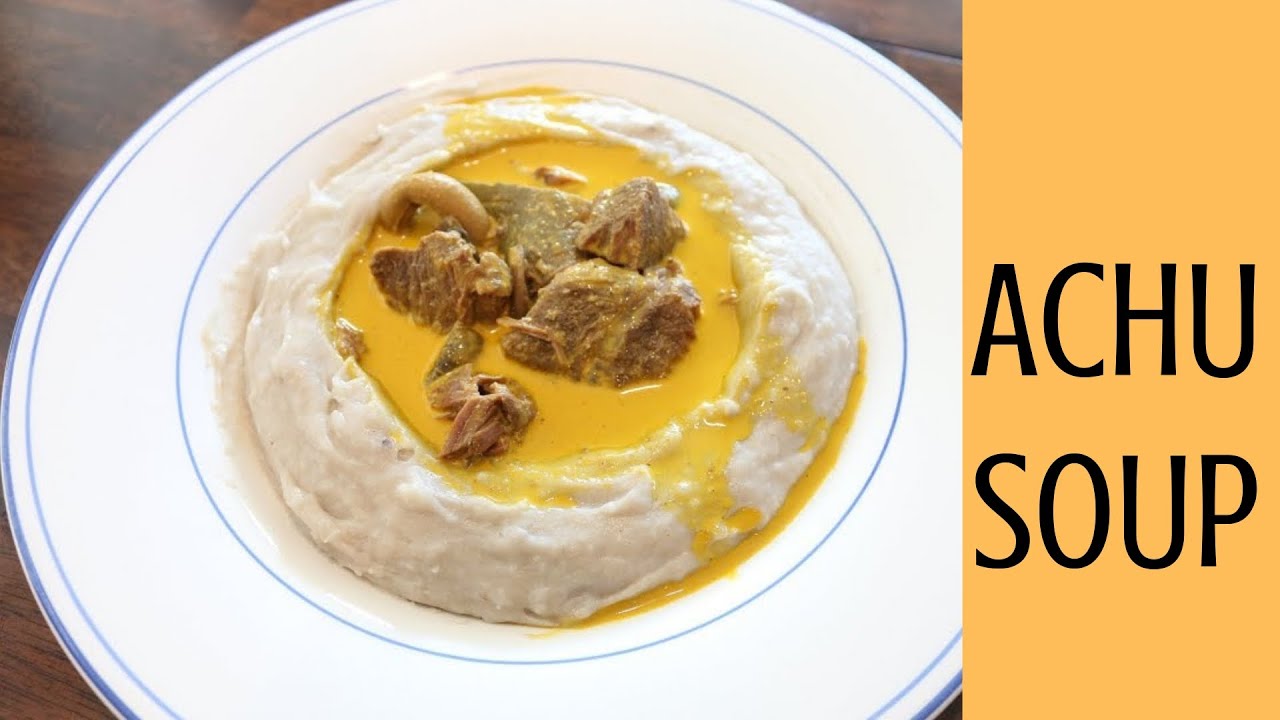Achu Soup: Authentic Yellow Palm-Oil Soup with Taro Fufu Recipe from Scratch

Achu Soup is a celebrated dish from the Western regions of Cameroon—rich, aromatic, and vibrant with its signature yellow color from palm oil. Traditionally served with taro fufu, this exquisite soup has long been a festive favorite, symbolizing heritage and communal joy. In this guide, you’ll learn how to prepare Achu Soup from scratch, complete with detailed steps, essential ingredients, expert tips, and variations to help you recreate an authentic Cameroonian culinary experience at home.
Table of Contents
- What is Achu Soup?
- Historical Background and Cultural Significance
- Essential Ingredients
- Step-by-Step Preparation Process
- Cooking Tips and Variations
- Serving Suggestions
- FAQs on Achu Soup
- Conclusion
What is Achu Soup?
Achu Soup, often referred to as the “yellow soup” of Cameroon, is a sumptuous blend of yellow palm oil, aromatic spices, and tender meat or fish—culminating in a rich, flavorful stew. It is traditionally paired with taro fufu, a smooth, starchy accompaniment made from boiled taro tubers that perfectly complements the soup’s vibrant texture and taste. This dish is more than just food; it’s a reflection of Cameroonian culinary artistry and communal dining culture.
Historical Background and Cultural Significance
Originating in the Western part of Cameroon—particularly within the Bamenda region—Achu Soup has evolved from a dish once reserved for festive and high-profile gatherings into a beloved staple found in local households. Its distinct yellow hue and harmonious balance of bitter, savory, and slightly spicy notes exemplify the resourcefulness and creativity of Cameroonian cooks. Over generations, Achu Soup has become an integral part of the national culinary identity, celebrated for its depth of flavor and cultural richness.
Essential Ingredients
For an authentic Achu Soup that serves 6–8 people, you will need:
For the Soup:
- Yellow Palm Oil: ½ cup (provides the characteristic color and flavor)
- Chicken or Beef (Optional): 1–1.5 kg, cut into pieces (substitute with fish for a lighter version)
- Water or Stock: 3–4 cups (adjust for desired consistency)
- Ground Crayfish: 2–3 tablespoons (for depth and umami)
- Fresh Garlic: 4 cloves, minced
- Fresh Ginger: 1 tablespoon, grated
- Scotch Bonnet Pepper: 1, deseeded and finely chopped (optional, for heat)
- Onions: 2 medium, chopped
- Local Achu Spice Blend: 1–2 teaspoons (a unique mix of traditional spices; if unavailable, blend a pinch of turmeric, a dash of paprika, and a touch of ground nutmeg)
- Salt and Black Pepper: To taste
- Bay Leaves: 2 (optional)
For the Taro Fufu:
- Taro Tubers: 1–1.5 kg, peeled and cut into chunks
- Water: As needed for boiling
- Salt: A pinch
Step-by-Step Preparation Process
Preparing the Soup Base
- Sauté Aromatics:
In a large, heavy-bottomed pot, heat the yellow palm oil over medium heat. Add the chopped onions, minced garlic, and grated ginger. Sauté for about 3–5 minutes until the onions soften and become translucent. - Incorporate the Spices:
Add the scotch bonnet pepper and your local achu spice blend (or your homemade substitute). Stir well to allow the spices to release their flavors.
Cooking the Meat (Optional)
- Brown the Meat:
If using meat, add the chicken or beef pieces to the pot. Sauté until they are lightly browned on all sides. Browning the meat helps to lock in flavor and adds a savory depth to the soup. - Add Liquid:
Pour in the water or chicken/beef stock, ensuring the meat is partially submerged. Add bay leaves, salt, and black pepper. Bring the mixture to a gentle simmer.
Combining Flavors and Final Simmer
- Incorporate Ground Crayfish:
Stir in the ground crayfish to enrich the broth with a deep, savory flavor. Allow the soup to simmer for 20–25 minutes, or until the meat is tender and the flavors are well blended. - Adjust Consistency and Seasoning:
Taste the soup and adjust salt, pepper, or spice levels as necessary. If you desire a thicker consistency, let the soup simmer uncovered for an additional 5–10 minutes.
Preparing Taro Fufu
- Boil the Taro:
While the soup simmers, place the taro chunks in a large pot, cover with water, and add a pinch of salt. Boil until the taro is soft and easily pierced with a fork (approximately 20–30 minutes). - Pound the Taro:
Drain the taro and transfer it to a mortar or a large bowl. Using a pestle or a sturdy masher, pound or mash the taro until smooth and elastic. You may add a little warm water to achieve a soft, dough-like consistency. - Shape the Fufu:
Once pounded to the desired consistency, shape the taro fufu into balls or serve it as a soft, dough-like side.
Cooking Tips and Variations
- Consistency Is Key: For the soup, adjust the liquid amount to achieve your preferred consistency. A slightly thicker soup clings beautifully to the fufu.
- Meat Variations: Experiment with different proteins. For a lighter version, use fish; for a heartier meal, try goat meat.
- Spice Adjustments: If you prefer a spicier dish, add extra Scotch bonnet or a pinch of cayenne pepper.
- Vegetarian Option: Omit meat entirely and increase the quantity of aromatics and spices. Consider adding mushrooms or tofu for added protein.
Serving Suggestions
Achu Soup is traditionally served hot alongside taro fufu. Here are some serving ideas:
- With Taro Fufu: Scoop a generous portion of taro fufu and dip it into the rich, flavorful Achu Soup.
- With Boiled Yams or Plantains: For a variation, serve the soup with other starchy sides like boiled yams or plantains.
- Garnish: Top with fresh herbs such as chopped parsley or basil to add a burst of color and freshness.
FAQs on Achu Soup
Q1: What makes Achu Soup distinct?
A1: Achu Soup is renowned for its vibrant yellow color, which comes from high-quality palm oil. Its unique blend of spices and the rich, savory flavor of the ground crayfish make it a standout dish in Cameroonian cuisine.
Q2: Can I make Achu Soup without meat?
A2: Absolutely! The soup’s deep flavors come from the spices and palm oil, so you can easily omit meat for a vegetarian version. Enhance the dish with additional vegetables or tofu.
Q3: How do I achieve the perfect taro fufu?
A3: Boil the taro until completely soft and then pound it until smooth and elastic. Adding a little warm water during pounding can help achieve a smooth, dough-like consistency.
Q4: What side dishes pair best with Achu Soup?
A4: Traditionally, Achu Soup is served with taro fufu, but it also pairs well with boiled plantains, yams, or even a simple rice dish.
Conclusion
Achu Soup is a true gem of Cameroonian cuisine—a sumptuous, yellow palm-oil stew that perfectly balances spicy, savory, and slightly tangy flavors. Paired with taro fufu, it offers a comforting yet exotic dining experience that reflects the culinary heritage of Cameroon. Whether you’re preparing it for a family celebration or exploring new flavors in your kitchen, this detailed guide will help you create an authentic dish from scratch.
Enjoy your culinary adventure and share your Achu Soup experience with friends and family!



